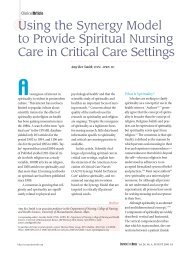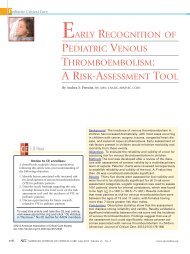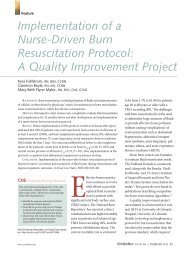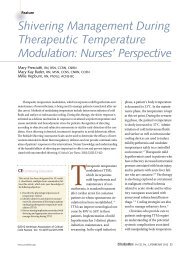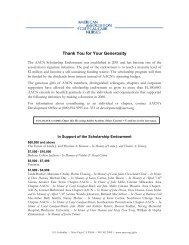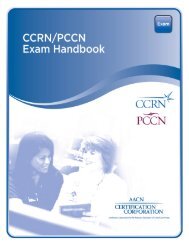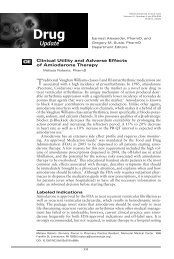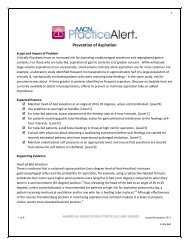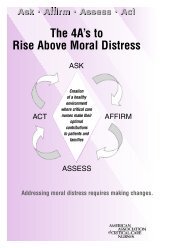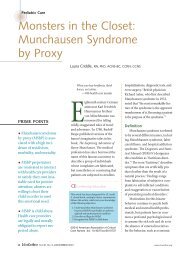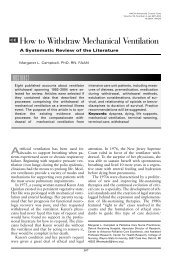Chlorhexidine, Toothbrushing, and Preventing Ventilator Associated ...
Chlorhexidine, Toothbrushing, and Preventing Ventilator Associated ...
Chlorhexidine, Toothbrushing, and Preventing Ventilator Associated ...
Create successful ePaper yourself
Turn your PDF publications into a flip-book with our unique Google optimized e-Paper software.
<strong>Ventilator</strong>-associated pneumonia (VAP) is defined as pneumonia in patients receiving<br />
mechanical ventilation that was neither present nor developing at the time<br />
of intubation. VAP increases mortality, 1 hospital length of stay, 2,3 <strong>and</strong> health care<br />
costs. 2,4,5 Oral health can be compromised by critical illness <strong>and</strong> by mechanical<br />
ventilation <strong>and</strong> is influenced by nursing care. 6,7 The effect of oral care interventions<br />
on the development of VAP has been of interest to clinicians; however, data from well-controlled<br />
experimental research with adequate sample sizes have not been published.<br />
Many risk factors for VAP have been identified. 8<br />
Major ones include inadequate h<strong>and</strong> washing by<br />
staff, ventilatory circuit management practices, supine<br />
positioning of patients without backrest elevation,<br />
previous antibiotic therapy, presence of a nasogastric<br />
tube, <strong>and</strong> gastric alkalinization. 9,10 Interventions<br />
included in the Institute for Healthcare Improvement’s<br />
ventilator bundle 11 to reduce risk of complications<br />
in patients treated with mechanical ventilation<br />
include elevating the head of the bed to 30º or more,<br />
prophylaxis for peptic ulcer disease <strong>and</strong> deep vein<br />
thrombosis, daily interruption of sedation (sedation<br />
vacation), <strong>and</strong> assessment of readiness to extubate.<br />
Another risk factor for VAP is colonization of<br />
the oropharynx by potential pathogens such as<br />
Staphylococcus aureus, Streptococcus pneumoniae, or<br />
gram-negative rods. 12-15 Several factors contribute to<br />
the association between oral health <strong>and</strong> development<br />
of VAP. Within 48 hours of admission to the intensive<br />
care unit (ICU), oral flora of critically ill patients<br />
undergoes a change to predominantly gram-negative<br />
flora that includes more virulent organisms. 16,17 Dental<br />
plaque can provide a habitat for microorganisms<br />
responsible for VAP, <strong>and</strong> dental plaque of patients<br />
in the ICU can be colonized by potential respiratory<br />
pathogens such as methicillin-resistant S aureus <strong>and</strong><br />
Pseudomonas aeruginosa. 18<br />
Because contamination of the oral cavity by pathogenic<br />
bacteria is associated with VAP, interventions<br />
About the Authors<br />
Cindy L. Munro <strong>and</strong> Mary Jo Grap are professors in the<br />
Adult Health Department, School of Nursing; Donna K.<br />
McClish is an associate professor, Department of Biostatistics;<br />
<strong>and</strong> Curtis N. Sessler is a professor in the Division<br />
of Pulmonary <strong>and</strong> Critical Care Medicine,<br />
Department of Internal Medicine, School of Medicine, at<br />
Virginia Commonwealth University, Richmond, Virginia.<br />
Deborah J. Jones is an assistant professor, Acute <strong>and</strong><br />
Continuing Care Department, University of Texas School<br />
of Nursing at Houston.<br />
Corresponding author: Cindy L. Munro, RN, PhD, ANP, Professor,<br />
School of Nursing, Virginia Commonwealth University,<br />
Box 980567, Richmond, VA 23298-0567 (e-mail:<br />
cmunro@vcu.edu).<br />
to reduce bacteria in the oral cavity have been investigated.<br />
Several studies 19-21 have indicated that application<br />
of topical oral chlorhexidine, initiated before<br />
intubation, reduces nosocomial infections in patients<br />
having elective cardiac surgery. Importantly, however,<br />
cardiac surgery patients are generally extubated<br />
within 48 hours <strong>and</strong> thus have a<br />
low risk for VAP. However, in a<br />
recent meta-analysis, Pineda et al 22<br />
found that chlorhexidine did not<br />
reduce nosocomial pneumonia or<br />
mortality rate. A recommendation<br />
for use of chlorhexidine in patients<br />
other than those having elective cardiac<br />
surgery is not included in<br />
national ventilator bundles or in<br />
recommendations from the Centers<br />
for Disease Control <strong>and</strong> Prevention because no evidence<br />
of the effectiveness of chlorhexidine in general<br />
critical care patients is available. Controlled<br />
studies of the effects of toothbrushing on VAP have<br />
not been reported.<br />
Oral care in critically ill adults is now emerging<br />
as an important issue but has not been well studied<br />
in patients other than those having elective cardiac<br />
surgery. We conducted a r<strong>and</strong>omized, controlled<br />
clinical trial to test the effects of toothbrushing<br />
<strong>and</strong>/or chlorhexidine in reducing the risk for VAP in<br />
adult ICU patients receiving mechanical ventilation.<br />
We hypothesized that oral interventions would reduce<br />
the incidence of VAP.<br />
Methods<br />
Design <strong>and</strong> Sample<br />
A r<strong>and</strong>omized controlled 2 × 2 factorial experimental<br />
design was used, <strong>and</strong> staff who performed<br />
interventions had no knowledge of patients’ Clinical<br />
Pulmonary Infection Score (CPIS). The study was<br />
approved by the Office of Research Subjects Protection<br />
of Virginia Commonwealth University, Richmond,<br />
Virginia, <strong>and</strong> prospective informed consent<br />
for participation was obtained from each patient’s<br />
Dental plaque can<br />
provide a habitat<br />
for microorganisms<br />
responsible for<br />
ventilator-associated<br />
pneumonia.<br />
www.ajcconline.org AJCC AMERICAN JOURNAL OF CRITICAL CARE, September 2009, Volume 18, No. 5 429



